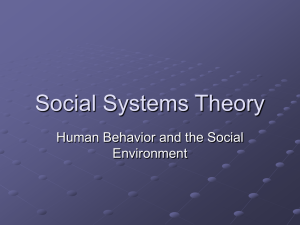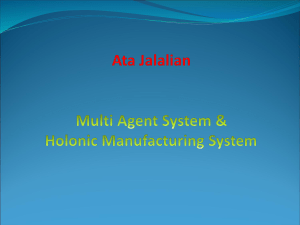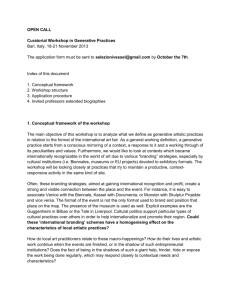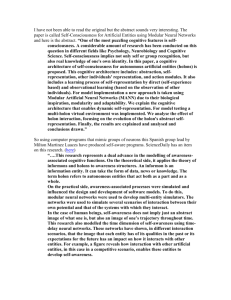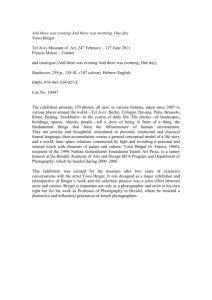Research Journal of Applied Sciences, Engineering and Technology 6(23): 4399-4404,... ISSN: 2040-7459; e-ISSN: 2040-7467
advertisement
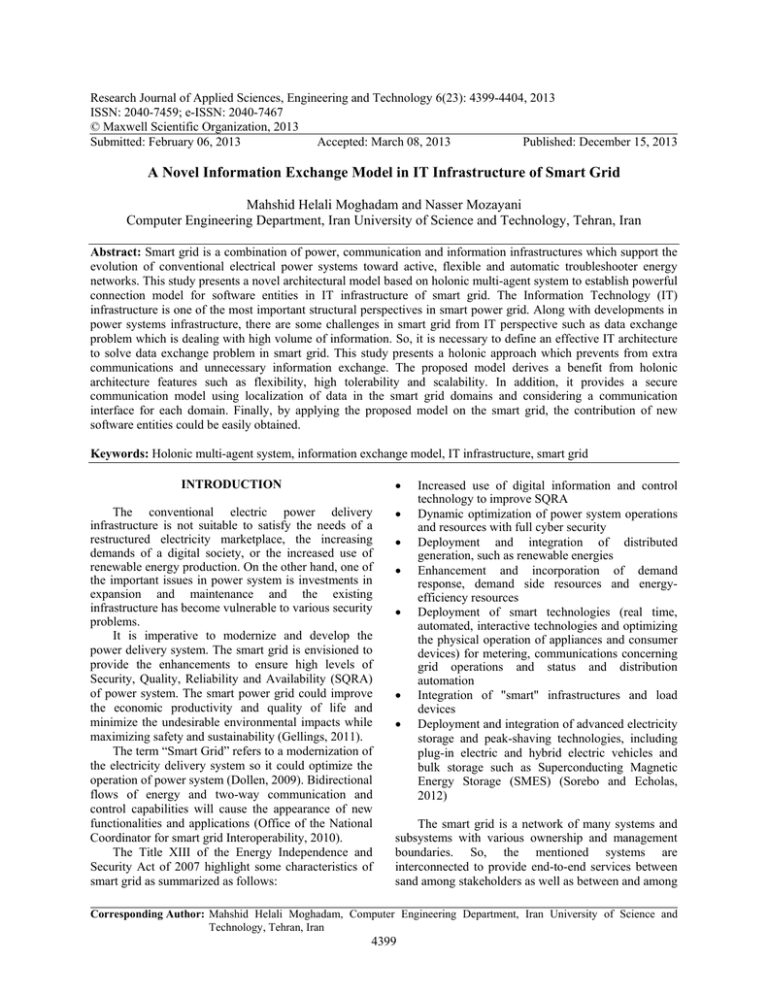
Research Journal of Applied Sciences, Engineering and Technology 6(23): 4399-4404, 2013 ISSN: 2040-7459; e-ISSN: 2040-7467 © Maxwell Scientific Organization, 2013 Submitted: February 06, 2013 Accepted: March 08, 2013 Published: December 15, 2013 A Novel Information Exchange Model in IT Infrastructure of Smart Grid Mahshid Helali Moghadam and Nasser Mozayani Computer Engineering Department, Iran University of Science and Technology, Tehran, Iran Abstract: Smart grid is a combination of power, communication and information infrastructures which support the evolution of conventional electrical power systems toward active, flexible and automatic troubleshooter energy networks. This study presents a novel architectural model based on holonic multi-agent system to establish powerful connection model for software entities in IT infrastructure of smart grid. The Information Technology (IT) infrastructure is one of the most important structural perspectives in smart power grid. Along with developments in power systems infrastructure, there are some challenges in smart grid from IT perspective such as data exchange problem which is dealing with high volume of information. So, it is necessary to define an effective IT architecture to solve data exchange problem in smart grid. This study presents a holonic approach which prevents from extra communications and unnecessary information exchange. The proposed model derives a benefit from holonic architecture features such as flexibility, high tolerability and scalability. In addition, it provides a secure communication model using localization of data in the smart grid domains and considering a communication interface for each domain. Finally, by applying the proposed model on the smart grid, the contribution of new software entities could be easily obtained. Keywords: Holonic multi-agent system, information exchange model, IT infrastructure, smart grid INTRODUCTION • The conventional electric power delivery infrastructure is not suitable to satisfy the needs of a restructured electricity marketplace, the increasing demands of a digital society, or the increased use of renewable energy production. On the other hand, one of the important issues in power system is investments in expansion and maintenance and the existing infrastructure has become vulnerable to various security problems. It is imperative to modernize and develop the power delivery system. The smart grid is envisioned to provide the enhancements to ensure high levels of Security, Quality, Reliability and Availability (SQRA) of power system. The smart power grid could improve the economic productivity and quality of life and minimize the undesirable environmental impacts while maximizing safety and sustainability (Gellings, 2011). The term “Smart Grid” refers to a modernization of the electricity delivery system so it could optimize the operation of power system (Dollen, 2009). Bidirectional flows of energy and two-way communication and control capabilities will cause the appearance of new functionalities and applications (Office of the National Coordinator for smart grid Interoperability, 2010). The Title XIII of the Energy Independence and Security Act of 2007 highlight some characteristics of smart grid as summarized as follows: • • • • • • Increased use of digital information and control technology to improve SQRA Dynamic optimization of power system operations and resources with full cyber security Deployment and integration of distributed generation, such as renewable energies Enhancement and incorporation of demand response, demand side resources and energyefficiency resources Deployment of smart technologies (real time, automated, interactive technologies and optimizing the physical operation of appliances and consumer devices) for metering, communications concerning grid operations and status and distribution automation Integration of "smart" infrastructures and load devices Deployment and integration of advanced electricity storage and peak-shaving technologies, including plug-in electric and hybrid electric vehicles and bulk storage such as Superconducting Magnetic Energy Storage (SMES) (Sorebo and Echolas, 2012) The smart grid is a network of many systems and subsystems with various ownership and management boundaries. So, the mentioned systems are interconnected to provide end-to-end services between sand among stakeholders as well as between and among Corresponding Author: Mahshid Helali Moghadam, Computer Engineering Department, Iran University of Science and Technology, Tehran, Iran 4399 Res. J. Appl. Sci. Eng. Technol., 6(23): 4399-4404, 2013 intelligent devices. The IT infrastructure of smart grid MATERIALS AND METHODS assumes responsive, secure and reliable information dissemination to any point in the grid where the In this study, the proposed architectural model is information is needed to make decisions or perform based on holonic structure. This study suggests holonic critical monitoring such as transmission line multi-agent system for information exchange in IT monitoring. With many opportunities for analysis and infrastructure of smart grid. In the following sections a optimization using information technology, the smart brief introduction to holonic multi-agent systems and grid will increasingly become more dynamic in its the proposed information exchange model based on configuration and its support of real-time operational holonic systems will be presented. conditions, (IEEE Standards Coordinating Committee 21, 2011). Holonic multi-agent systems: The holonic concept In a complex system, like smart grid with was developed for describing recursive and self-similar increasing number of sub systems and interactions structures in the biological and social organizations. between them, it is essential to implement an effective Holon is the basic concept and primary unit of holonic IT architecture to optimize data exchange and manage structures. A holon depending on how to be seen can be the communications and data flows of the system. So, considered as an autonomous atomic entity or an in this study, a new holonic architectural model is organization including some sub-holons. Holons can proposed for interactions and data exchange between consist of some sub-holons and also be a part of a larger the software entities in the IT infrastructure of smart one. Consequently, a tree structure is formed that it's grid. members work together to achieve a complex goal. This The holonic (Koestler, 1967) structure was tree-like structure is called holarchy. Holarchy is a formulated by Hungarian philosopher Koestler to hierarchical structure of self-regulating holons which explain the evolution of biological and social systems their functionality and communications are studied (Giret and Botti, 2004). It is able to synergistically from following aspects: combine both autonomous and cooperative behavior efficiently to achieve system goals. Holonic structure is • As an autonomous wholes in supra-ordination to one of the suitable structures for modeling many their parts complicated systems such as manufacturing, education, • As dependent parts in sub-ordination to controls on transportation, traffic control systems, etc. The concept higher levels of fractal and holonic systems was proposed to combine • In co-ordination with their local environment. top-down hierarchical organizational structure with Tree-like structure or in other words the holarchy decentralized control, which takes the bottom-up of holons has unique features such as stability and perspective. The holonic structure is adaptable to resistance to internal and external disturbances and environmental changes and is a cooperative, selfdisorders. These structures support efficient use of organizing, flexible and reconfigurable one (Van resources and have high adaptability to Brussel et al., 1998; Chirn and McFarlane, 2000; Botti environmental changes (Giret and Botti, 2004; and Giret, 2008; Hilaire et al., 2008; Versteegh et al., Botti and Giret, 2008; Mella, 2009). It provides 2008).The fundamental units of this structure are information encapsulation in the system and holons. The holons may consist of sub-holons and also controls the access of entities to the information. be a component of a super-holon. So a recursive tree The idea of holonic structure is a combination of structure called holarchy is made by holons. There are a top-down hierarchical and distributed control lot of examples of holarchy such as human body. The structures. A super-holon is a holon that contains holarchy structure can be also considered for many some sub-holons .Super-holon as an entity has its social organizations (Fischer et al., 2003; Giret and own features and characteristics that are Botti, 2004; Hilaire et al., 2008). determined by its constituent members (Hilaire In this study, a new architectural model is proposed et al., 2008). Figure 1 illustrates a view of holarchy for the IT infrastructure of smart grid by using the or holonic structure (Helali Moghadam and concept of holonic multi-agent systems. In this IT Mozayani, 2011). architectural model, every software entity is assumed as a software agent. The whole network is assumed as a Three types of internal structure were proposed for holon that consists of some domain holons. Also each holonic multi-agent systems as summarized as follows: domain holon comprises some software holons. Every Software holon is composed of some of the same i. A holon as a federation of autonomous agents. In software entities. In addition, a head agent with some this structure sub-holons are fully autonomous specific tasks is assumed for every holon and by using agents with a predefined architecture and the superunique features of holonic architecture, a new IT holon is just a new conceptual entity which is architectural model for interactions and data exchange composed of sub-holons and its properties are between software entities of smart grid is presented. 4400 Res. J. Appl. Sci. Eng. Technol., 6(23): 4399-4404, 2013 Fig. 1: A view of holarchy or holonic structure made up by the properties of the sub-holons. Agents do not lose their autonomy and super-holon is realized exclusively through cooperation among the sub-holons ii. Several agents merge into one. In this case the agents are integrated into a whole one and a new agent is created as a union of agents. The capability of this new agent includes functionalities of the former agents. In this process, the agent loses its own autonomy completely but can recover after ending the life of super-holon. In this approach, for splitting and merging holons, some special methods should be specified iii. A holon as a moderated group. In this case the agents lose some parts of their autonomy. One of the agents is determined as the head of holon that represents the super-holon in the external world; it means it is the communication interface of the holon with external world. The head of holon can allocate the resources to the agents that are inside the holon and also plan and manage a negotiation between them. The head of holon will be determined primarily by one of two following methods: • For determining the head of holon, a new agent is created as a head for the life time of holon • A member of the holon takes the role of head and accepts the extra duties. In this method, this member of holon is elected during an election or is predestined for the leadership (Fischer et al., 2003). The mentioned head acts as the interface for communicating with non-member holons and also represents members, who are masked to the outside world (Rodriguez et al., 2006). Proposed information exchange model in IT infrastructure of smart grid: The conventional power system could be divided into different domains as follows: Generation, transmission, distribution, control and operation, service provider, market and customer. In the smart grid, there are noticeable information flows between software entities of one domain and also of different domains. So, it is necessary to use a robust IT structure for data exchange in the smart grid. In the proposed model, software entities of IT infrastructure of smart grid are assumed as software agents. The whole smart grid is assumed as smart grid holon which is composed of some domain holons. Generation, transmission, distribution, control and operation, service provider, market and customer domains are considered as domain holons. So the sub-holons of the smart grid holon are domain holons. On the other hand, in each domain holon, a software holon is established for each kind of software agent in that domain holon. A Software holon is composed of some software agents of the same type. Therefore, a domain holon may include some software holons. Some of the most well-known types of software entities or software holons in generation, transmission, distribution, control and operation, service provider, market and customer domains are as follows: • • • • • • OMS holon, DMS holon, GIS holon, DMWF holon in the distribution holon SCADA holon, MDM holon in the control and operation holon EMS holon in the transmission holon BMS holon in the customer holon CIS holon, Billing holon and demand management holon in the service provider holon Dispatch and plant control holon in the generation holon Where OMS is outage management system, so the OMS holon consists of OMS software entities in the distribution domain. DMS is distribution management system, GIS is geographical information system and DMWF is distribution mobile workforce management. Also in control and operation domain, SCADA is supervisory control and data acquisition. In 4401 Res. J. Appl. Sci. Eng. Technol., 6(23): 4399-4404, 2013 Fig. 2: Proposed holarchy for IT infrastructure of smart grid The responsibilities of the head agent in the software holon as a communication interface are as follows: • • Fig. 3: The head agents of software holons and the flow of information transmission domain, EMS is energy management system. In customer domain, BMS is building management system and in service provider domain, CIS is customer information system (IEEE Standards Coordinating Committee 21, 2011). A software holon may consist of only one software agent or some software agents which are dispersed in different areas of the domain e.g., DMS software holon in distribution holon consists of DMS software agents which are distributed in distribution domain. Figure 2 a view of the proposed holarchy for IT infrastructure of smart grid. In the proposed architectural model, a head software agent is assumed for each holon. In software holon, the head is responsible for establishing communication between agents inside the software holon. It can also make communication between the inside agents and software agents in other software holons in the domain holon. The head of domain holon makes connections between software holons inside the domain. It also makes communications between them and software holons in other domains. The head agent in the software holon as an information exchange interface is shown in Fig. 3. Communicates with software agents in the holon and sends/receives information to/from them Communicates with head agents in other software holons and sends/receives information to/from them The tasks of the head agent in a domain holon are as follows: • • Communicates with head agents of the software holons in the domain holon and sends/receives information to/from them Communicates with head agents in other domain holons and sends/receives information to/from them It is necessary to specify some patterns and standard protocols for communication between agents at different levels. Communicating could be through some methods like messaging or web services etc. In the proposed model, there are three types of data exchange between software agents in the smart grid as follows: A. Intra-software holon data exchange B. Inter-software holon data exchange in domain holon C. Inter-domain holon data exchange 4402 Res. J. Appl. Sci. Eng. Technol., 6(23): 4399-4404, 2013 agent from a specific software holon wants to exchange information with a software agent from another software holon. At first, the origin agent communicates with the head agent in its software holon, then, the head agent of the origin software holon communicates with the head agent of the destination software holon. The head of the destination software holon communicates with the destination software agent. So the data will be exchanged through the heads of the software holons. Communication between an OMS entity and a DMWF entity in the distribution domain, in order to dispatch personnel and equipment for outage mitigation is an example of this type of data exchange (IEEE Standards Coordinating Committee 21, 2011). Figure 5 shows the process of data exchange between software holons in a domain holon C. In inter-domain holon data exchange, one software agent from a specific domain holon wants to exchange information with a software agent from another domain holon. At first, the origin agent communicates with the head agent of its software holon, then the head of origin software holon communicates with the head agent of its domain holon. Thereafter the head agent of the origin domain holon communicates with the head of the destination domain holon, then the head of the destination domain holon communicates with the head of the destination software holon. Lastly, the head of the destination software holon communicates with the destination software agent. In this type of information exchange, data will be exchanged through two types of head agents at different levels. An important example of this connection is the communication between the EMS entity and Plant Control entity for making coordination, in order to improve the line dynamic rate. Figure 6 shows the data flow in inter-domain holon data exchange. Fig. 4: Data flow in intra-software holon data exchange Fig. 5: The process of data exchange between software holons in a domain holon Fig. 6: Data flow in inter-domain holon data exchange The scenarios of data exchange in the mentioned types of communication between software agents are as follows: A. In intra-software holon data exchange, two software agents in a software holon want to exchange information with each other. In this connection, data will be exchanged through the head agent of the software holon. The origin agent communicates with the head agent and transmits its request or its information to the head agent, then the head agent communicates with the destination agent and transmits the information to it or receives the information from it and transmits the information to the origin agent. A sample of this interaction is the communication between GIS entities in GIS holon in order to make coordination. The data flow in this type of data exchange is shown in Fig. 4 B. Inter-software holon data exchange occurs in domain holon. In this connection, one software RESULTS AND DISCUSSION This study proposes a systematic approach to organize the process of data exchange between software entities in different areas of smart grid. The proposed architectural model is an organized structure that eliminates the irregularities in communications and provides scalability and security mechanisms for information exchange in IT infrastructure of smart grid. In the proposed architecture, data will be monitored at different levels by the head of holons. It provides a kind of powerful security mechanism for important and vital data in the smart grid. It also benefits from holonic structure features such as flexibility, high tolerability and scalability. So changing and scaling up in the IT infrastructure could be easily obtained. Holonic structure due to its 4403 Res. J. Appl. Sci. Eng. Technol., 6(23): 4399-4404, 2013 localization feature and forming different zones prevents the spread of fault effects in the grid. On the other hand, regardless of specific features of this structure, there are some prerequisites in order to implement this information exchange model. It is necessary to improve some parts of the existing infrastructures such as power system and communication system. It is essential to produce new softwares according to this structure and change the existing softwares in order to be adapted to this information exchange model. To establish communication between software entities based on this architecture, specific communication protocols for different levels of the structure should be specified and also suitable communication media at different zones of the architecture must be determined. CONCLUSION One of the important issues in implementing smart grid is organizing the IT infrastructure of smart grid. This study presents a new IT architectural model based on holonic structure to improve the process of information exchange. In the proposed approach, the IT infrastructure of smart grid is assumed as a holonic multi-agent system and software entities of the IT infrastructure are assumed as software agents. The proposed holonic architecture provides flexibility and scalability for the system. So the IT infrastructure could easily scale up and the contribution of new software entities could be obtained. The specific structure of the holonic architecture prevents from fault effect expansion in the grid, so it provides high tolerability in the network. This architecture provides a secure mechanism for data exchange by localization of data in the smart grid domains and considering communication interfaces at different levels. In fact, data will be monitored at different levels by the head of holons. The proposed structure organizes the communications between IT entities in the smart grid. With organizing communications and data exchanges, the power system could behave appropriately in fault detection and prevention in the network. REFERENCES Botti, V. and A. Giret, 2008. Anemona: A Multi-Agent Methodology for Holonic Manufacturing SystemsSpringer Series in Advanced Manufacturing. Springer. Chirn, J. and D.C. McFarlane, 2000. A holonic component-based approach to reconfigurable manufacturing control architecture. Proceedings of the 11th International Workshop on Database and Expert Systems Applications, Sep., 06-08, pp: 219. Dollen, D.V., 2009. Report to NIST on the Smart Grid Interoperability Standards Roadmap. Electric Power Research Institute (EPRI), USA. Fischer, K., M. Schillo and J. Siekmann, 2003. Holonic multiagent systems: A foundation for the organisation of multiagent systems. Lect. Notes Comput. Sci., 2744: 71-80. Gellings, C., 2011. Estimating the Costs and Benefits of the Smart Grid: A Preliminary Estimate of the Investment Requirements and the Resultant Benefits of a Fully Functioning Smart Grid. Electric Power Research Institute (EPRI), USA. Giret, A. and V. Botti, 2004. Holons and agents. J. Intell. Manuf., 15(5): 645-659. Helali Moghadam, M., N. Mozayani, 2011. A street lighting control system based on holonic structures and traffic system. Proceeding of 3th International Conference on Computer Research and Development, China, pp: 92-96. Hilaire,V.,A. Koukam and S. Rodriguez, 2008. An adaptive agent architecture for Holonic multi-agent systems. ACM Trans. Auton. Adap.Syst.,3(1):1-24. IEEE Standards Coordinating Committee 21, 2011. IEEE Guide for Smart Grid Interoperability of Energy Technology and Information Technology Operation with the Electric Power System (EPS). End-Use Applications and Loads, USA. Koestler, A., 1967. The Ghost in the Machine. Hutchinson & Co., London. Mella,P.,2009.TheHolonicRevolution:Holons, Holarc hies and Holonic Networks: The Ghost in the Production Machine. Pavia University Press, Pavia. Office of the National Coordinator for Smart Grid Interoperability, 2010. NIST Framework and Roadmap for Smart Grid Interoperability Standards. Release 1.0, National Institute of Standards and Technology (NIST). Rodriguez, S., N. Gaud, V. Hilaire and A. Koukam, 2006. Modeling holonic systems with an organizational approach. Fourth European Workshop on Multi-Agent Systems (EUMAS'06), Lisbon, Portugal. Sorebo, G.N. and M.C. Echolas, 2012. Smart Grid Security: An End-to-End View of Security in the New Electrical Grid. CRC Press, Taylor & Francis Group. Van Brussel, H., J. Wyns, P. Valckenaers, L. Bongaerts and P. Peeters, 1998. Reference architecture for holonic manufacturing systems: PROSA. Comput. Ind., 37(3): 255-276. Versteegh, F., M.A. Salido and A. Giret, 2008. A Holonic architecture for the global road transportation system. J. Intell. Manuf., 21(1): 133-144. 4404
